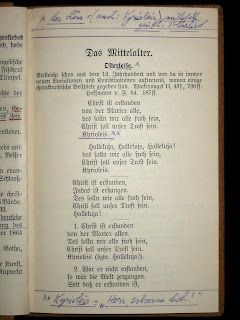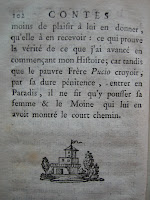
Not too long ago my sister-in-law was on a professional trip to Zurich, Switzerland and, knowing of my bibliophilia, returned with a few gifts to add to Tarquin Tar’s Bookcase. This week’s book is one of those items.
Published in 1912 in Berlin and Leipzig by G. J. Göschen, the book is Das Deutsche Kirchenlied in seinen charactteristeschen Erscheinungen {German Church Music in Representative Examples} by University of Strasbourg professor of theology Dr. Friedrich Spitta (1852-1924), a noted Protestant preacher and scholar of Jewish descent. This particular copy is of volume one of Spitta’s study: “Mittelalter und Reformationszeit” {“Middle Ages and Reformation”}. Because the book was mass-produced as part of an educational series (see below), the title is not exceptionally rare, though I do notice that all of the dealers currently offering it for sale are located in Germany, so I suspect it is somewhat uncommon here in the United States.
The book is volume 602 in the prodigious Sammlung Göschen {Göschen Collection}, a series of pocket-sized books that was launched by the firm founded by the then-deceased publisher Viscount George Joachim Göschen (1752-1828) in 1889 for the express purpose of offering highly quality, durable books of German texts, edited by leading scholars of the day, and sold at a price (80 cents) that made them accessible for school use across Germany. The first ten volumes in the series focused on classic works of the German enlightenment; volume eleven introduced science to the mix (on astronomy, by A. F. Möbius, the mathematician who lent his name to the famed Möbius Strip geometric form) and the next year the popular series expanded to include a variety of fields, such as education, geology, psychology, mythology, and logic.

After the turn of the century, the series changed its mission from school use to use in the universities and the number of titles it offered increased exponentially, reaching 500 in 1910 and 1000 in 1931. After the turn of the century the series was acquired by publisher Walter de Gruyter (though the series name did not change) and continued to be issued into the mid-1990s. With an active production of new titles for over a century, the Sammlung Göschen is one of the longest-running scholarly series of books of the modern age. The series mission statement, as it appeared in volumes throughout the twentieth century (including this one), reads:
To present our current knowledge in short, clear, universally understood monographs. The purpose and objective of the Göschen Collection is to provide, in individual examples, a clear, easily understandable, and concise introduction to all areas of science and technology and to give, through close examination on a strictly scientific basis and taking into account the latest research, the most reliable information possible. Each topic is discrete, but all volumes possess an inner relationship with each other, so it is expected that the whole thing, when completed, will exist as a uniform, systematic presentation of all of our entire knowledge.

Designed for the convenience of the student reader, the book is a slim volume, bound in durable tan cloth with inked titles, borders, and publisher’s device (an eagle standing over the letters “GJG”) on the cover. Its corners are rounded slightly, but this is from wear and not part of the book’s deliberate production. The pages measure 10cm x 15cm and are of a dull gloss, lightweight stock. As with most continental books, the signatures are numeric rather than (as they are in England and America) alphabetical. The collational formula may be expressed as 8o: [#] 18-98 [π]: $2 with the exception of gathering 1 in which the first leaf is not signed. The second leaf of each is signed with an asterisk (*) after the gathering number. On the inner lower corner of the initial page of each gathering is the name of the author and volume title -- something that, as I’ve noted previously, was no doubt meant as an aid to the printer in keeping sheets from multiple volumes in the same series from being confused.

This indicates, of course, that the printer was employed on more than one title at a time (which would probably have been necessitated by the series’ rapid dissemination of new titles). The initial leaf and ultimate leaf are conjugate directly with the endpapers pasted down inside the front and back covers respectively; the ultimate leaf is a blank fly and the initial is a catalog list advertising other related volumes in the series (the front cover’s paste-down has the series mission statement). Pages 128 and 129 have split apart somewhat, revealing that the gatherings were bound together with iron staples which have started to rust slightly and then were pasted down along their edge into the binding. Beginning with the title page [11r] the pagination runs throughout the book as [1] through 141 (on [97r]) with only p. 140 unmarked.

As the title indicates, the book is a collection of hymns and devotional songs of the early German church. Following a four page introduction in which Spitta summarizes the history of the use of music in German religious services, there is a chapter of 29 Catholic hymns from the Middle Ages. After this is the section on the Reformation hymnodists, which begins with a chapter presenting 20 hymns by Martin Luther, followed by chapters containing 42 hymns from 19 other German theologians and musicians as well as from several different traditions (including “The Könisberger Songs” and “Mart Gras Songs”). Several of the Catholic hymns are in Latin; all of the Protestant hymns are in German. Throughout, Spitta provides brief explanatory remarks before some of the verses to set them into their context and brief biographical paragraphs on the writers; he also frequently cites other scholarly works (including his own) for further reading. At the end there is an index of hymns by first lines.

One of the reasons my sister-in-law thought I’d like this book is because of my interest in marginalia. My copy has been closely read and used for its scholarly purposes by a very conscientious reader. Up until p. 57 nearly every page has been carefully marked with either red ink or blue ink (or both) to underline or box in specific passages. The same reader has used a system of “x” marks within the text (or “xx” on pages with more than one annotation) to refer to marginal glosses he or she has added. These glosses provide German translations of specific Latin words with which the reader was evidently unfamiliar and, in some cases, suggests cross-references to other hymns or composers in the book. What strikes me most about this marginalia is its intense precision; usually readers marking in a book tend to be casual (they’re readers, after all, not writers) and even when making notations to aid future readings they’re often only leisurely about aligning their marks (especially if they are college students). This reader, though, uses a tidy system of notation and clearly used a straight-edge for all the underlining and boxing.

There is even a deliberate switch between blue and red ink in the markings: based on how the two colors line up when they are used it is clear that they were both added by one reader and at one time, which meant the reader had a particular reason (indiscernible to me, alas) for using blue ink or red ink in marking the text at particular places. The only place where both inks underline a phrase is the first two words of Luther’s “Der Glaube zu deutsch” {The Faith of the German”} on page 50, of which the first line reads “Wir glauben all an einen Gott” {“We all believe in one God”}. Likewise, some of the marks used to draw attention to various passages differ from single underlines to double underlines, single marginal lines to double marginal lines, and in some places text boxes.
Of course, this is one of the reasons I enjoy browsing through old books -- they don’t only provide evidence of how their authors wrote or their makers printed but they are also our best (and often only) real evidence of how readers before us read, thought about, and responded to the ideas they contain. But, as the Deutsche Kirchenlied reader’s switching between red ink and blue or his seemingly arbitrary use of underlining in some places and text boxes in others reminds me, no matter how much evidence these readers’ marks offer up, their system of codes and their purposeful selectivity always leave incredible gaps. These silences compel us to accept that we and our readerly forerunners have only this miniscule connection -- as thin and fragile as the sheets of paper on which the book is printed -- and we will never have, nor should we worry ourselves too much in trying to find, all the answers about the readers who have come before us. We, too, will someday be mysteries to those who in a hundred years read the same books that we have read -- people who, like us, will struggle to catch just a fleeting glimpse of their predecessors in the margins of our books.


























